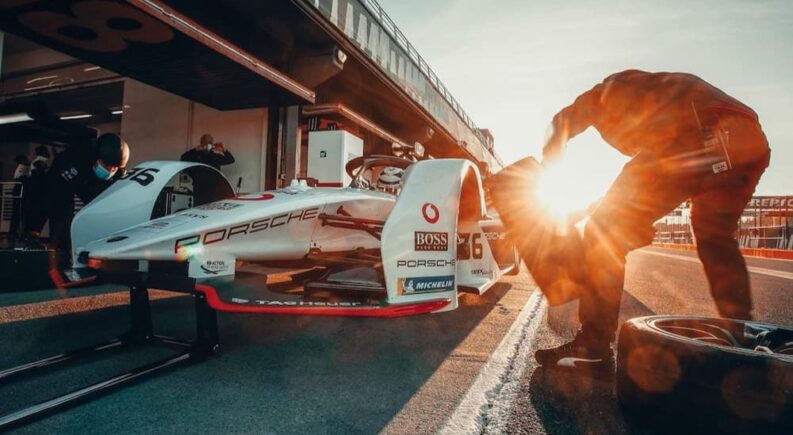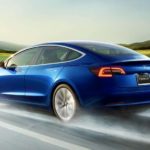Almost as soon as it was invented, the horseless carriage was put to use for racing. The 24 Hours of Le Mans just celebrated its 100th anniversary, meaning that by 1923 enough rich playboys were racing each other to justify major organized events. Bentley, Maserati, Alfa Romeo, Ferrari, and Jaguar all have roots in racing, and the technological advancements made by wealthy men trying to drive faster contributed directly to improvements in regular old road cars. From disc brakes to Multimatic DSSV dampers, track-devised innovations have always found themselves adapted for road car applications.
Conceived by then-FIA President Jean Todt in 2011, the idea behind Formula E was to do the same thing for EVs. More than a decade later, this all-electric racing series is still going strong! The league has an established track record of delivering sustainability and inclusivity initiatives around the world while continuously pushing the envelope of sustainable vehicle technology. Now in its ninth competitive season and running a third-generation electric race car, the ABB FIA Formula E World Championship delivers on its promise to drive progress to a more sustainable future; I think that’s a promise that deserves a closer look. So what is Formula E?
The Greatest Test of Driving Skill
You’ll note that Formula E’s official name is “ABB FIA Formula E World Championship”––that’s a special designation, as the only other racing series granted FIA World Championship status are Formula One, the World Endurance Championship, and the World Rally Championship! So it’s no small thing to suggest that in some key aspects, Formula E is more competitive and more exciting than either of the other FIA World Championships––I do think I’m daring to say that it’s currently the greatest driving competition in the world!
Why? How could I say such a thing? The answer, you see, is the car. Because unlike in Formula One, Formula E teams are all driving the same car, and they always have since the beginning. Though today’s builds allow manufacturers to sort out the specifics of the powertrain, everyone’s using the same chassis, battery, and tires, making for an incredibly level playing field where each driver’s performance has an outsized impact on the results. Unlike Formula One, where the best car is most likely to win no matter who’s driving it, in Formula E, it’s all about the driver and the crew supporting them.
The Car That Makes It Happen
Because every team is driving the same car, that makes the car a really important part of the competition. Today’s carbon fiber and aluminum monocoque is wholly designed and built by Spark Racing Technologies––an electric race car manufacturer founded in 2012 to support Formula E. With a weight of only 1,680 lbs––over 130 lbs lighter than the Gen 2 model––and power settings that alternate between 402 and 469 hp depending on the rules of the moment, it rockets to a top speed exceeding 200 mph!
Performance like that requires a special tire, which for Gen 3 is made by Hankook (prior iterations were provided by Michelin). Incorporating sustainable rubber and bio-materials, the tires are designed for all-weather traction throughout the duration of each race without requiring a pit stop to change them. These tires look like they’d be right at home on a road-going sports car and strike quite the contrast with the wide, smooth racing slicks used in Formula One races, but it’s all for a good cause. Enabled by the durable, all-weather design, tire allocations are restricted to two sets per car per event to reduce waste and transportation emissions, and used tires are recycled for use in manufacturing, energy, and construction!
The third unifying factor and a hallmark of the car since the beginning is a Williams Advanced Engineering battery pack, currently with 47 kWh of capacity––smaller than most modern EVs. A decade ago, the obvious problem for Gen 1 was range and charging. Nobody wants a half-hour intermission for a recharge, so the solution was to have the driver leap out of one car, hop in another, and go finish the race! Yikes. Gen 2 featured a better battery but also introduced a time-based format that allowed the cars to run a whole race without pit stops as long as teams managed energy effectively. Now for Gen 3, it’s back to a lap-based format, but that’s okay because the cars are capable of “flash charging.”
This is cool. You know that the fastest EV chargers on our roads are DC fast chargers like the Tesla Superchargers, right? They crank about 250-350 kW in order to push those 10-80% recharges in less than half an hour. I’m calling it right now that flash charging is the future to put those systems to shame because these race cars are built to receive power at a rate of 600 kW! That’s enough power to restore 4 kWh in one 30-second pit stop, putting back nearly 10% of the car’s range in a flash (more on this later)! What’s more, is that Gen 3 is the first to have a motor on the front axle––but not to give the car AWD. This motor is purely for regenerating the battery. Combined with the rear motor, the total regen capability is also 600 kW and accounts for 40% of the energy used during a race!
The Show to Thrill a New Generation
Now that we’ve covered the details of the vehicle that everyone’s driving let’s review how the competition works. Formula E features 11 teams and 22 drivers in Season 9, with 16 races queued up in 11 cities around the world. A unique feature of Formula E is that every circuit is a city road track, bringing all of the tight confines, sharp turns, and exciting proximity which that type of venue provides. It also makes the races more accessible to the local population and reduces the carbon footprint of fans traveling to attend since they can do so by public transit!
All of the events of a race take place on the same day. There are a couple half-hour practice sessions to warm everybody up, then qualifiers a couple hours later. The qualification structure, used to determine starting grid positions, has a fun tournament-style layout. The drivers are split into two groups; the four fastest drivers from each group enter a dueling tournament where the winner takes the pole position (and claims points toward the World Championship). The main event then starts about an hour later.
Where Videogames Meet Reality
There’s one feature unique to Formula E that completely changes the way a team should approach each race: “boost.” The rear motor’s output power is limited to 402 hp for the race, but there are ways to temporarily unlock the full 469 hp and apply a real-life power boost in-race! Viewers can tell when a boost is active because the cockpit’s protective halo lights up in colored LEDs, with the color dependent on the type of boost that’s active.
Originally, there was the controversial Fanboost (magenta lights). For a few days leading up to the race, fans could vote for their favorite driver to get a boost, thereby allowing fans to directly influence the outcome! The concept was cool, especially since voting closed after the race began––meaning drivers didn’t know who was going to get the Fanboost until they were already underway!
The drawbacks to this were A) that it amounted to a popularity contest, which I’m not exactly thrilled to see in a sport, and B) Has FIA heard of Twitter bots, capable of flooding polls with fake votes? There were definitely issues and polarized opinions with this feature, and though I have to admit that fans directly providing a “home track advantage”––even for just a few seconds in the second half of the race––was a cool and unexpected feature, eliminating Fanboost for Season 9 was probably for the best.
The second way to get a boost is Attack Mode (blue lights), which was introduced for Season 5 and added a genuine videogame element to Formula E racing! Specific areas off of the track’s racing line are designated as “activation zones,” like an item spawn point in Mario Kart, and driving through them grants an Attack Mode boost. Drivers lose some time by hitting the activation zones, but the boosts are well worth the risk. Previously, the number and duration of boosts for each race were announced only an hour ahead of race time––limiting the ability to flesh out a detailed strategy for using them––but for Season 9, teams can now customize how they want to use their boost.
FIA has also teased a third boost opportunity that was supposed to be trialed at select Season 9 races but has since been postponed to Season 10. That would be Attack Charge, which is simply the awarding of extra Attack Mode boosts to drivers who execute a 30-second recharging pit stop at the ultra-high 600 kW charge rate. The idea is that although a pit stop costs time and isn’t strictly necessary in the current format, incorporating a pit stop allows drivers to push the cars much harder––rewarding them with extra boosts will compound that effect! However, plugged-in charging for the cars is currently capped at 350 kW, and pit stops are not part of the race equation.
This departure from the plan relates to a domino effect of battery spec changes back in early 2022. It’s a safe call to scrap the feature for this year, as shoehorning it into what are the most critical races of the season––essentially changing the game––doesn’t sit well with fans or competitors alike. Think about it––not only would you be throwing more boosts into the mix, but you’d also introduce long pit stops and the lap disadvantages they create while completely disrupting the regular driving strategy that each team has been honing from the beginning. With each team only able to charge one car at a time, there’s also the hard fact that somebody’s going to lose out on opportunities to win by being forced to pit early or late. I definitely agree that it’s better to put off the introduction of Attack Charge until next year, when everyone can be dealing with the effects of the change from day one.
A New Competition for a New Automotive Era
The effects of Formula E are already being felt by road cars around the world. Thanks to Nissan’s participation in Formula E, the LEAF’s standard battery capacity has increased by 180% since 2014. Jaguar used data from its drivers’ lift and coast cycles to inform the predictive energy optimization for its own award-winning EVs, and Audi, BMW, and Mercedes have all used participation in Formula E to develop their burgeoning electric platforms.
What’s more (although I don’t have room to cover it here), Formula E delivers on its social objectives, earning recognition from the Global Sustainability Benchmark in Sports as the most sustainable sport in the world. It has built wind farms to offset its emissions, hosted Smart Cities forums to develop sustainable city growth solutions, distributed water in reusable pouches at events, and provided free events and workshops via FIA Girls on Track to empower girls to break into an industry in sore need of diversity.
Formula E aims to be a sport we can all feel good about supporting. The FIA is leveraging the sport to make great advancements for people, the environment, and cars in general and is leveraging the unique characteristics of electric vehicles to provide a unique racing experience that just might be the most exciting in the world. With innovative techniques for getting fans more involved and one of the most tightly controlled vehicle specs of any racing series, the ABB FIA Formula E World Championship is exciting, forward-thinking, and above all, the most sustainable sport in the world!




